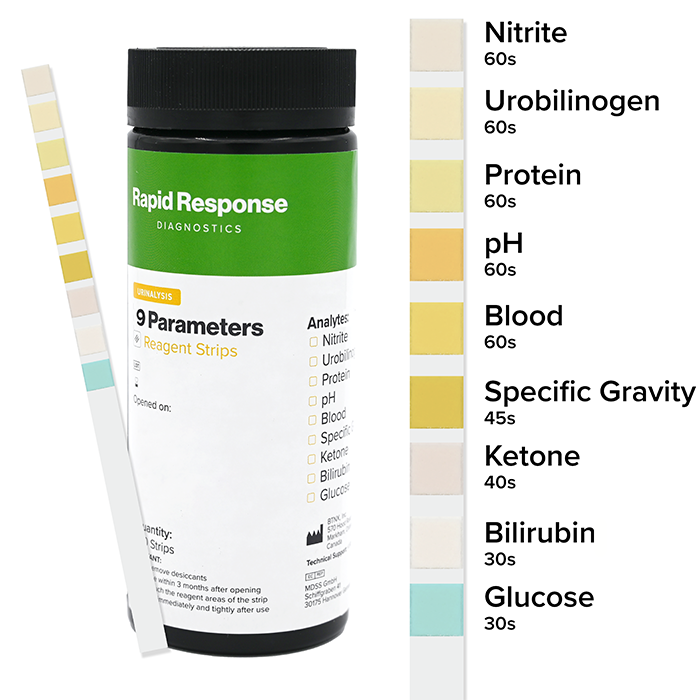
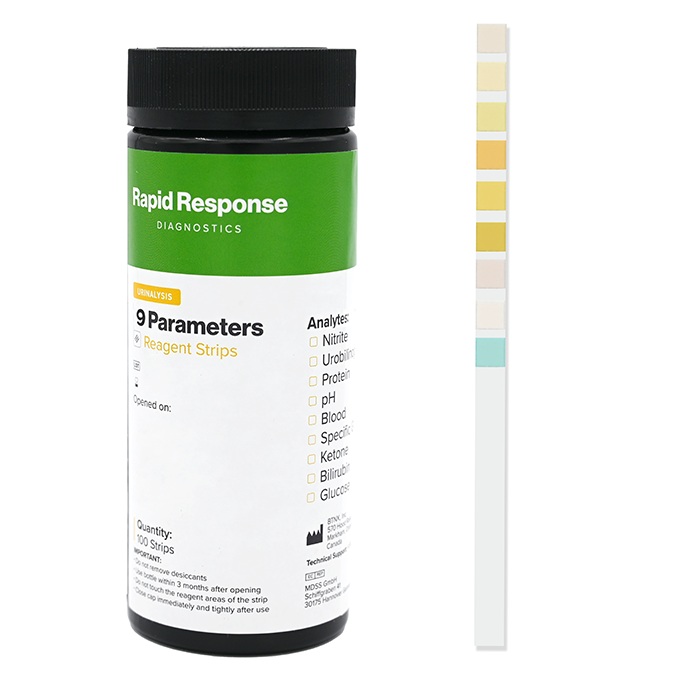
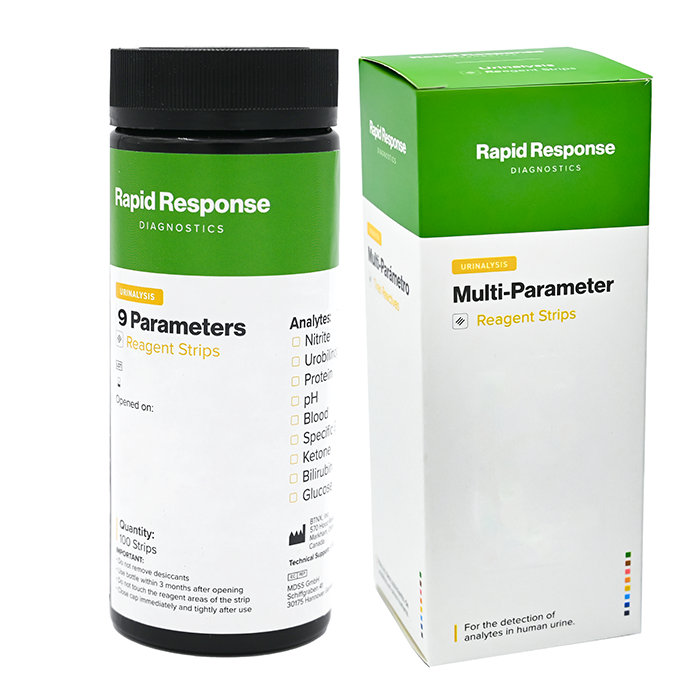
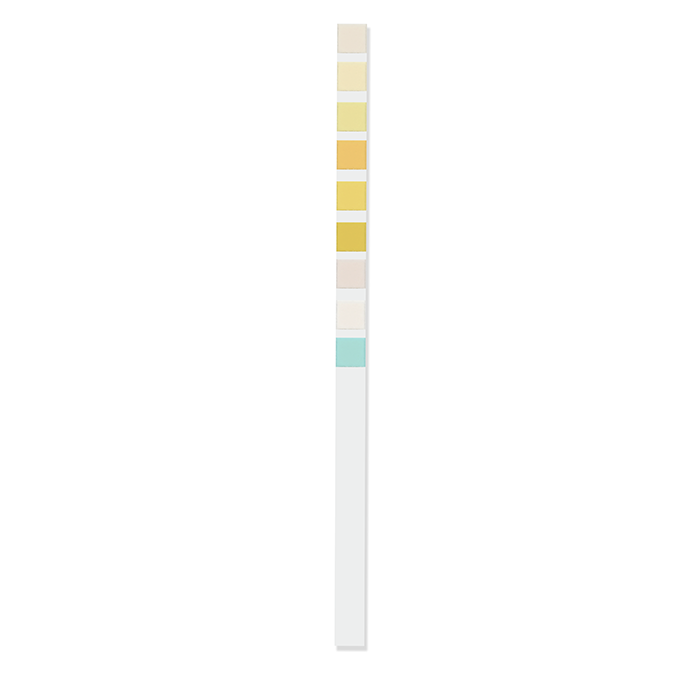




The Rapid Response™ Urinalysis Reagent Strip are qualitative and semi-qualitative dip-and-read test for the detection of urine analytes in human urine, to aid in the general evaluation of health and in the diagnosis and monitoring of metabolic or systemic diseases.
The 9 Parameter Rapid Response™ Urinalysis Reagent Strip simultaneously detects Glucose, Bilirubin, Ketone, Specific Gravity, Blood, pH, Protein, Urobilinogen, and Nitrite in urine.
Compatible with the Rapid Response™ Urine Analyzer U121S. To learn more, visit the U121S product page.
The Rapid Response™ Urinalysis Reagent Strip are qualitative and semi-qualitative dip-and-read test for the detection of urine analytes in human urine, to aid in the general evaluation of health and in the diagnosis and monitoring of metabolic or systemic diseases.
The 9 Parameter Rapid Response™ Urinalysis Reagent Strip simultaneously detects Glucose, Bilirubin, Ketone, Specific Gravity, Blood, pH, Protein, Urobilinogen, and Nitrite in urine.
Compatible with the Rapid Response™ Urine Analyzer U121S. To learn more, visit the U121S product page.
Simultaneously Detects 9 Urine Parameters
Fast & Reliable Results in 60 Seconds
User-Friendly

- Completely immerse the reagent areas of the strip in fresh, well-mixed urine.
- While removing the strip from the urine, run the edge of the strip against the rim of the urine container to remove excess urine.
- Compare the reagent areas to the corresponding color blocks on the canister label at the specified times.
Instructions simplified for illustrative purposes. Always read and follow the product insert or user manual before use.
Glucose (GLU) 30 Seconds
Detects glucose as low as 50-100 mg/dL (2.5-5 mmol/L).
Glucose should not be detected in normal urine. Small amounts of glucose may be excreted by the kidney.3 Glucose concentrations as low as 100 mg/dL may be considered abnormal if results are consistent.
Expected Results: Negative
Bilirubin (BIL) 30 Seconds.
Detects bilirubin as low as 0.4-1.0 mg/dL (6.8-17 μmol/L).
In normal urine, no bilirubin is detectable by even the most sensitive methods. Even trace amounts of bilirubin require further investigation. Atypical results (colors different from the negative or positive color blocks shown on the color chart) may indicate that bilirubin-derived bile pigments are present in the urine specimen and are possibly masking the bilirubin reaction.
Expected Result: negative
Ketone (KET) 40 Seconds.
Detects acetoacetic acid as low as 2.5-5 mg/dL (0.25-0.5 mmol/L).
Detectable ketone levels may occur in urine during physiological stress conditions such as fasting, pregnancy and frequent strenuous exercise.4-6 In starvation diets, or in other abnormal carbohydrate metabolism situations, ketones appear in the urine in excessively high concentration before serum ketones are elevated.7
Expected Results: Negative
Specific Gravity (SG) 45 Seconds.
Determines urine specific gravity between 1.000 and 1.030. Results correlate with values obtained by refractive index method within ± 0.005.
Randomly collected urine may vary in specific gravity from 1.003-1.035.8 Twenty-four-hour urine from healthy adults with normal diets and fluid intake will have a specific gravity of 1.016-1.022.8 In cases of severe renal damage, the specific gravity is fixed at 1.010, the value of the glomerular filtrate.
Expected Results: low at 1,000 but normal ranges from 1.020 to 1.030
Blood (BLO) 60 Seconds.
Detects free hemoglobin as low as 0.018-0.060 mg/dL or 5-10 Ery/μL in urine specimens with ascorbic acid content of < 50 mg/dL. Blood is often, but not invariably, found in the urine of menstruating females. The significance of a trace reading varies among patients and clinical judgment is required in these specimens.
Expected result: Negative.
pH 60 Seconds
Permits the quantitative differentiation of pH values within the range of 5-9.
This test is based on a double indicator system which gives a broad range of colors covering the entire urinary pH range. Colors range from orange to yellow and green to blue. The expected range for normal urine specimens from newborns is pH 5-7.9 The expected range for other normal urine specimens is pH 4.5-8, with an average result of pH 6.9
Protein (PRO) 60 Seconds
Detects albumin as low as 7.5-15 mg/dL (0.075-0.15 g/L).
1-14 mg/dL of protein may be excreted by a normal kidney.10 A color matching any block greater than trace indicates significant proteinuria. Clinical judgment is required to evaluate the significance of trace results.
Expected result: Negative
Urobilinogen (URO) 60 Seconds
Detects urobilinogen as low as 0.2-1.0 mg/dL (3.5-17 μmol/L).
Urobilinogen is one of the major compounds produced in heme synthesis and is a normal substance in urine. The expected range for normal urine with this test is 0.2-1.0 mg/dL (3.5-17 µmol/L).8 A result of 2.0 mg/dL (35 µmol/L) may be of clinical significance, and the patient specimen should be further evaluated.
Expected result: less than 17 µmol/l (< 1mg/dl)
Nitrite (NIT) 60 Seconds.
Detects sodium nitrite as low as 0.05-0.1 mg/dL in urine with a low specific gravity and less than 30 mg/dL ascorbic acid.
Nitrite is not detectable in normal urine.9 The nitrite area will be positive in some cases of infection, depending on how long the urine specimens were retained in the bladder prior to collection. Retrieval of positive cases with the nitrite test ranges from as low as 40% in cases where little bladder incubation occurred, to as high as approximately 80% in cases where bladder incubation took place for at least 4 hours.
Expected result : Negative

Test with the Rapid Response™ U121S Urine Analyzer.
- Scan the barcode on the side of the canister or type the code into the U121S Urine Analyzer using the touchpad
- Completely immerse the reagent areas of the strip in fresh, well-mixed urine.
- Insert the strip into the U121S Urine Analyzer.
Wait for the U121S to print the results.
To learn more visit the U121S product page.
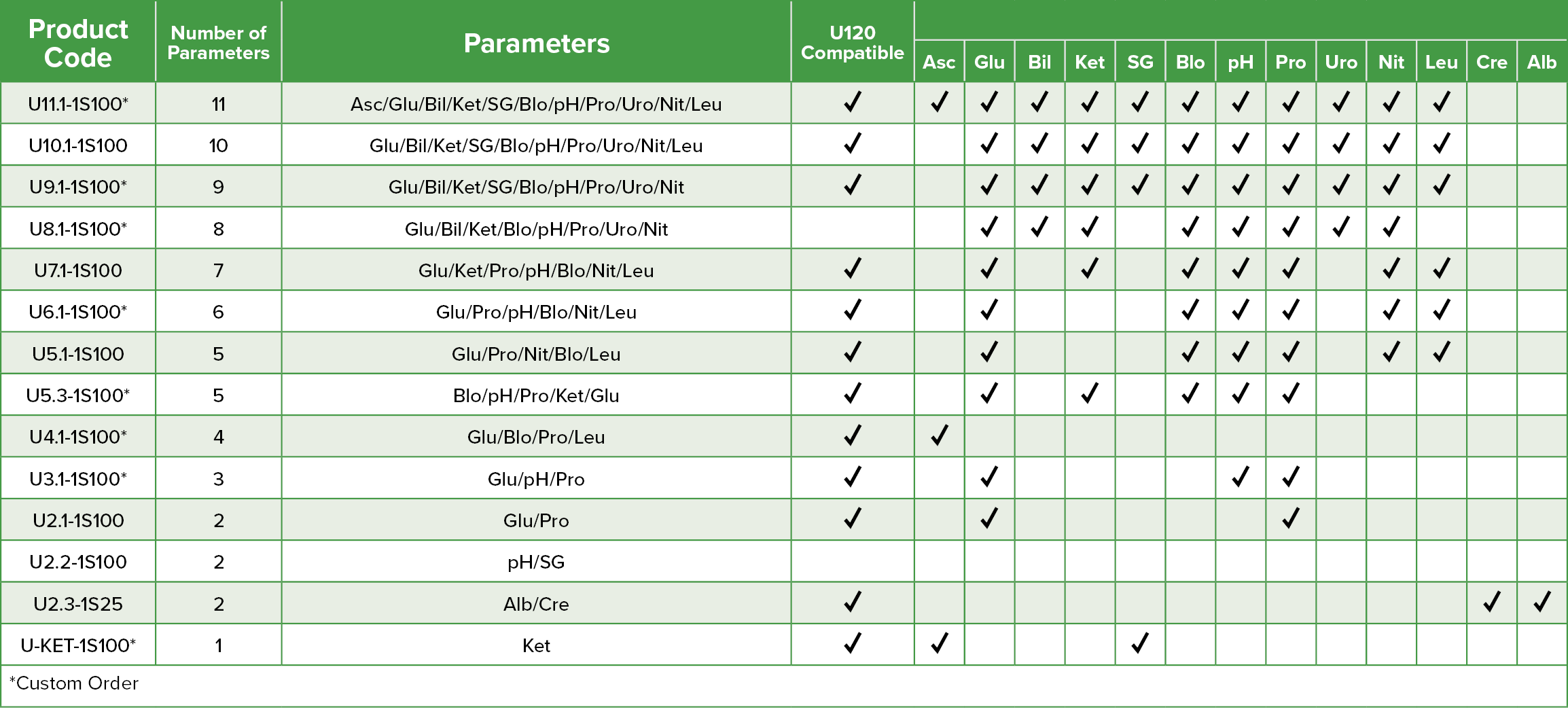
- Please note that certain products may only be available in specific regions; kindly consult with a sales representative for further information regarding product availability.
- The information provided on this website is for educational purposes only and should not be construed as medical advice. Always consult with a qualified healthcare professional regarding any medical concerns or conditions.
- Our products are intended for use as specified in the product documentation. It is important to carefully read and follow all instructions provided with the product.
